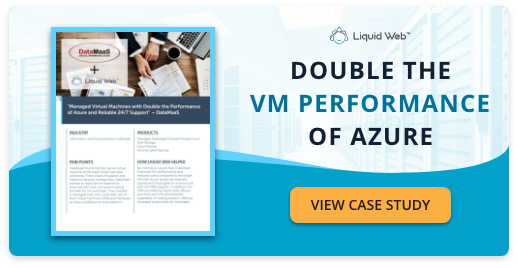
VMware high availability clusters (VMware HA clusters) can unlock amazing performance for your organization, turning technology into a game-changing competitive advantage. Doing so requires a plan to not just maximize success but also minimize potential disaster. For as powerful as HA clusters can be, the downsides of implementing and using them improperly can be a significant burden.
To get the most out of a VMware HA cluster, it is important to know some common use cases and how other industries and businesses leverage this advanced technology. From there, a straightforward set of best practices can serve as the foundation of success with high availability clusters in your own organization.
What is a VMware High Availability Cluster?

A VMware high availability cluster is a collection of computers that work together. This collection increases the reliability of applications and services. By using a clustered environment, organizations can minimize downtime caused by hardware failure. The computers in a high availability cluster are usually organized into two categories: nodes and servers.
- Nodes are the endpoint machines.
- Virtualized servers are the software that runs on those machines.
Nodes can be physical or virtual, but they must be connected to each other so that they can communicate and share data. In most cases, nodes are connected through a private network, but they can also be connected over the public Internet. Servers are the applications and services that run on the nodes. They can be anything from email servers and web servers to databases and file-sharing services.
The most important aspect of a high availability cluster is its ability to keep applications and services running even if one or more nodes fail. To do this, the cluster must have at least two nodes, and each node must have a copy of the data and applications that are being clustered. If one node fails, the other nodes in the cluster will take over and keep the applications and services running.
There are many different ways to configure a high availability cluster. The two most common configurations are active/passive and active/active.
In an active/passive configuration, one node is designated as the primary node, and the other nodes are standby nodes. The primary node handles all of the traffic and runs all of the applications and services. The standby nodes are there to take over if the primary node fails.
In an active/active configuration, all of the nodes are active, and each node handles a portion of the traffic. If one node fails, the other nodes will pick up the slack and keep the applications and services running. Active/active configurations are more complex than active/passive configurations, but they offer better VMware performance and uptime.
Common Use Cases for VMware HA Clusters
High availability clusters are commonly used to provide failover protection for mission-critical applications and services. By having at least two nodes in the cluster, organizations can ensure that their applications and services will remain up and running even if one node fails. This is especially important for applications and services that cannot tolerate any downtime, such as eCommerce websites and email servers.
One of the most common use cases for an HA cluster is as a file server. In this scenario, the cluster is used to store and serve large amounts of data that need to be accessible at all times. This could be things like customer records, financial data, or other types of business-critical information.
By using an HA cluster in this way, businesses can ensure that their data is always available and that there are no single points of failure.
High availability clusters are also commonly used to provide load balancing and scalability. By spreading the traffic across multiple nodes, organizations can ensure that their applications and services can handle more traffic without crashing. This is especially important for applications and services that experience spikes in traffic, such as eCommerce websites during the holiday shopping season.
VMware HA Cluster Best Practices

There are a few best practices that should be followed when setting up and using a VMware HA cluster.
First, it is important to have a clear understanding of the use case for the cluster. This will help ensure that the cluster is properly configured to meet the needs of the organization.
Next, it is important to have a good understanding of the underlying technology. This includes things like networking, storage, and server administration. Without this knowledge, it will be difficult to properly configure and maintain the cluster.
It is also important to have a well-defined plan for how the cluster will be used. This includes things like what applications and services will run on the cluster,
Going deeper, best practices range from technical considerations to strategic planning. Consider the following eight best practices as you deploy VMware HA clusters in your own environment.
Factor in Trade-Offs Between Simple and Complex
High availability clusters can provide a great deal of protection and flexibility for your organization, but they can also be complex and difficult to manage. In order to get the most out of an HA cluster, it is important to understand the trade-offs between simple and complex configurations.
- Simple HA Cluster: Easy to set up and requires less maintenance, but it may not provide the same level of protection and flexibility as a more complex cluster.
- Complex HA Cluster: More difficult to set up and requires more maintenance, but it can provide a higher level of protection and flexibility.
Plan for Unexpected Growth
When planning for unexpected growth with a VMware HA cluster, it is important to consider both the short-term and long-term needs of the organization as part of your best practices.
- Short Term: It may be necessary to add additional nodes to the cluster in order to handle increased traffic.
- Long Term: It may be necessary to redesign the cluster in order to accommodate more nodes.
Implement Robust Monitoring
In order to ensure that the HA cluster is performing optimally, it is important to monitor performance on a regular basis. This includes things like monitoring:
- Network traffic.
- Storage usage.
- Server utilization.
By monitoring performance, it will be easier to identify potential problems and take proactive steps to prevent them.
Plan for Unexpected Failure
Sometimes things do not go according to plan and even the simplest HA configuration can experience failure or downtime. That’s why when planning for an HA cluster, it is important to have a backup plan in place. This includes things like having a second cluster that can be used in the event of a failure. It is also important to have a plan for how data will be recovered in the event of a failure. Disaster recovery systems and failover clusters can be great protection against unexpected – and eventually inevitable – failure.
Reduce Latency Between Components
Any friction when passing bits and bytes through cluster components degrades performance and, ultimately, carries a negative downstream impact on team members and customers alike.
When setting up an HA cluster, it is important to reduce latency between cluster components. This can be accomplished by using a high-speed network and storage solution.
By reducing latency, it will be easier to maintain data consistency and prevent data loss.
Use a Version Control System
In order to keep the HA cluster configuration consistent, it is important to use a version control system. This will allow organizations to track changes to the cluster configuration and roll back changes if necessary.
A version control system simplifies the work and effort required to maintain a consistent cluster configuration and prevent problems.
What’s more, if you have a team of engineers all working in the same environment then a version control system will protect against accidental deployment errors while providing a reliable rollback system.
Consider Additional Integrated Services
Consider adding a few additional services as best practices when setting up a VMware HA cluster. These services include load balancers, shared file systems, and database clustering software.
Each of these services has its own set of best practices that should be followed in order to ensure a successful deployment:
- Load Balancer: Service that is used to distribute traffic evenly across multiple nodes in an HA cluster. By using a load balancer, it will be easier to distribute the workload evenly across the nodes in the cluster.
- Shared File System: File system that is used by multiple nodes in an HA cluster. By using a shared file system, it will be easier to keep data consistent across the nodes in the cluster.
- Database Clustering Software: Software that is used to cluster multiple databases together. By using database clustering software, it will be easier to keep the databases consistent across the nodes in the cluster.
Build-in Security from Step One
One of the most important aspects of an HA cluster is security. Without proper security measures in place, it is easy for unauthorized users to access sensitive data and disrupt the operations of the cluster.
There are many different security measures that can be implemented in an HA cluster.
- Authentication: One of the most basic security measures is authentication. By requiring users to authenticate before accessing the cluster, it will be more difficult for unauthorized users to gain access.
- Authorization: Another important security measure is authorization. This controls what users are able to do once they have authenticated. By restricting what users can do, it will be more difficult for them to cause disruption.
- Encryption: It is also important to implement encryption. This ensures that data is protected from being accessed by unauthorized users.
- Response: Finally, it is important to have a plan for how to respond to security incidents. This includes things like having an incident response team in place and having a plan for how to contain and recover from an incident.
This is just the beginning of a strong security posture for your cluster. Depending on your business needs and use case, different protections and security appliances may be required.
It is important to be mindful of these needs from the start, else you may find yourself having a cluster that is not as well protected as your business and customers require.
Is a VMware HA Cluster Right for Your Business?
When designing a VMware HA cluster, there are many factors to consider in order to ensure success. By following these best practices, organizations can maximize the benefits of an HA cluster while minimizing the potential for problems. With a well-designed and well-managed HA cluster, organizations can turn technology into a game-changing competitive advantage.
Our team at Liquid Web has worked with customers for more than twenty-five years to find the right infrastructure for their businesses. From hybrid cloud deployments to High Availability Clusters and VMware Private Cloud, Liquid Web is positioned to partner with your organization and provide the performance and support your workloads or applications require.
[ad_2]
Source link







